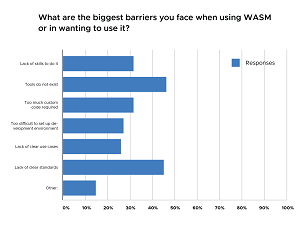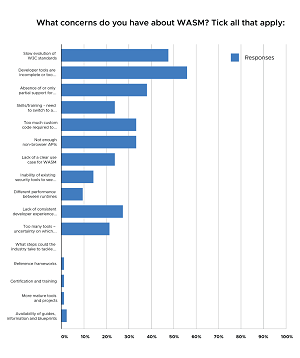Cloud Native WebAssembly Survey: Users ‘Hungry’ for Better Web-Dev Projects

Today is Wasm Day, marked by the Cloud Native Computing Foundation publishing a microsurvey about WebAssembly, a transformative web development technology that after five years is still leaving users wanting more.
“WebAssembly — or Wasm — has been warmly received since its first release in 2017, but our survey shows projects seem to be outstripping the capabilities of today’s tools and technologies and an overwhelming number of users hungry for fully-featured and stable Wasm projects,” the CNCF said in an Oct. 24 blog post.
The Mozilla Developer Network (MDN) — known for the Firefox web browser — is a primary backer of the tech, which it describes thusly:
WebAssembly is a new type of code that can be run in modern Web browsers — it is a low-level assembly-like language with a compact binary format that runs with near-native performance and provides languages such as C/C++ with a compilation target so that they can run on the Web. It is also designed to run alongside JavaScript, allowing both to work together.
The WebAssembly.org site provides another definition:
WebAssembly (abbreviated Wasm) is a binary instruction format for a stack-based virtual machine. Wasm is designed as a portable compilation target for programming languages, enabling deployment on the web for client and server applications.
In other words, developers can use Rust or C++ or C# or others as their primary programming language when doing browser-based web projects, instead of JavaScript.
Indeed, the CNCF’s microsurvey finds that Rust is the primary language (among 14) listed by respondents (59 percent) for their Wasm projects, followed by Go (47 percent) and JavaScript (46 percent).
The microsurvey, designed by CNCF, was conducted between September and October 2022 and received 93 responses. Its results were published during the start of the CNCF’s 2022 KubeCon + CloudNativeCon North America conference.
The CNCF said slightly more than a quarter of respondents (28 percent) are using Wasm in their cloud-native development projects with 36 percent planning to do so during the next six to 12 months, which the group said spoke to the general enthusiasm for Wasm, with 70 percent of respondents believing the runtime to be a disruptive emerging technology.
However, as noted above, the survey indicated users want more for that transformative tech.
“Despite the optimism and warm reception, developers are waiting for the Wasm industry and its technologies to stabilize. In fact, 33 percent of respondents had no plans to start working with Wasm,” the CNCF said.
“Absence of maturity may be causing concerns that are helping delay uptake. The biggest barriers to adoption were tools and standards, ranked first and second by a significant margin at 46 percent and 45 percent, respectively.”
The CNCF report follows a report last month indicating that while WebAssembly has made quite a splash in the web-dev world, it is “niche” tech whose usage is actually contracting. “Clearly WebAssembly isn’t widely used, and rather than seeing a growth in usage, we are seeing a modest contraction,” Colin Eberhardt said in a Sept. 25 post on the Web Almanac site by HTTP Archive.
The CNCF asked its respondents to elaborate on their Wasm desires.
“Just over half, 56 percent, said Wasm developer tools are jointly missing features and are difficult to use,” the CNCF said. “That was the single biggest obstacle. Close behind came slow development of industry standards by the World Wide Web Consortium (W3C) (48 percent). Language support was a leading issue, too. Despite WASM’s plurality, there’s a strong feeling that languages important to individual participants were either absent or only partially supported (38 percent).”
“What should the industry do to tackle these challenges?” the CNCF said. “Build fully-featured and stable Wasm tools and projects was the answer from 81 percent of respondents. This was the single biggest response to any one survey question — an indication of how widespread this problem is and how strongly people feel. There was a call from 60 percent for more leadership and advice from the industry with the development of Wasm programming guides and blueprints. Finally, 44 percent said the presence of reference frameworks would help them get their job done.”
Other data points of the report as presented by the CNCF include:
- Server-side development is a hotbed: 42 percent are writing, or plan to develop, server-wide applications using Wasm and 48 percent are combining or planning to combine server-side work with coding client-side applications. Just 18 percent are focused purely on client/browser.
- Nearly two thirds, 63 percent of survey respondents, said they are both porting new applications using Wasm and migrating existing workloads, compared with 37 percent who said they were creating new applications only.
- Wasm is being used, or is in the pipeline, on an array of applications and services where language choice is important and platform conditions can constrain performance. Serverless is a target for most of our participants (63 percent), followed by edge (54 percent) and web (52 percent).
- Asked what had attracted participants to the runtime, write-once-run-anywhere application portability came top (78 percent) with native runtime performance on 70 percent. Both are key issues in the speed and ease of development and application maintenance in highly-distributed multi-cloud environments. Wasm’s sandboxed security model rounded out the top three, at 77 percent.
About the Author
David Ramel is an editor and writer for Converge360.
Techyrack Website stock market day trading and youtube monetization and adsense Approval
Adsense Arbitrage website traffic Get Adsense Approval Google Adsense Earnings Traffic Arbitrage YouTube Monetization YouTube Monetization, Watchtime and Subscribers Ready Monetized Autoblog
from Web Development – My Blog https://www.techyrack.com/syndication/2022/10/24/cloud-native-webassembly-survey-users-hungry-for-better-web-dev-projects-virtualization-review/
via IFTTT



No comments:
Post a Comment